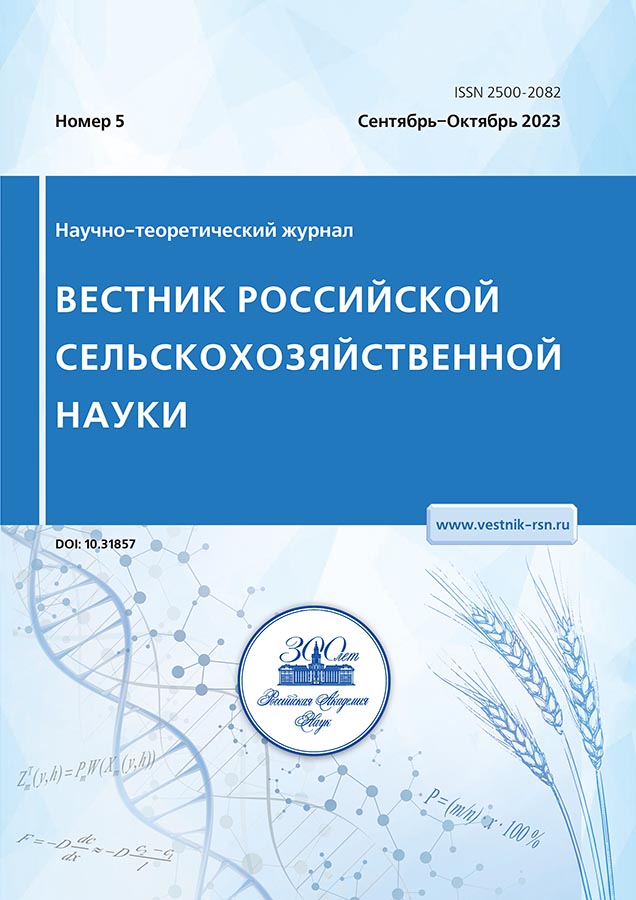FEATURES OF THE SOIL ACIDITIFICATION DYNAMICS IN AGRICULTURAL LANDSCAPE
Abstract
The results of long-term monitoring of the spatial dynamics of soil acidification within the terminal moraine hill are presented. The studies were carried out in 1996-2020. on the agro-ecological transect (VNIIMZ, Tver region) - an array crossing the landscape positions of the hill, consisting of 10 fields with an individual history. The exchangeable acidity of soils was determined at 30 sampling points, regularly located in each field at 40 m from each other. We used pHKCl data for 1996 and 2020 and acidification indicators determined as the difference in the values of soil exchange acidity at the beginning and end of observations. Statistical processing consisted in revealing the influence of anthropogenic and natural factors on soil acidification. It was found that the soils were significantly acidified during extensive farming. In 1996-2020 the average exchangeable acidity decreased by 0.6 (0.023 per year), but the soils did not move out of the slightly acidic category, which will take another 10 years. The spatial variability of pH significantly decreased: strongly acidic and neutral soils disappeared from the soil cover. It has been established that the landscape determines 34% of the spatial variability of soil acidification, and anthropogenic factors determine 26%. There are 4 groups of territories in the agrolandscape, significantly differing in the degree of soil acidification, which is explained by the heterogeneity of the relief and parent rocks. According to the diversity of anthropogenic impact, 5 groups of fields are distinguished, where differences in soil acidification are due to their history. In general, it is impossible to single out an anthropogenic factor in the agrolandscape that significantly affects the degree of soil acidification, however, the impact is noticeable on individual substowlands, which allows developing measures to reduce the intensity of this degradation factor. It is recommended to develop crop rotations within the tops of the hills and not to place fallows, hayfields and hatching fields with eastern goat's rue. On the middle, lower parts of the slopes and in inter-hill depressions, it is not recommended to place winter and cover crops.
References
2. Bulatova N.V., Regorchuk N.V. Plodorodie dernovo-podzolistoj pochvy i urozhajnost' mnogoletnih trav pri dlitel'nom primenenii mineral'nyh udobrenij na fone izvestkovaniya // Agrarnaya nauka Evro-Severo-Vostoka. 2017. №5. S. 28-32. https://doi.org/10.30766/2072-9081.2017.60.5.28-33
3. Vil'dflush I.R., Lapa V.V., Mishura O.I. Agrohimiya. Udobreniya i ih primenenie v sovremennom zemledelii: uchebno-metodicheskoe posobie. Gorki: BGSKHA, 2019. 405 s.
4. Gogmachadze G.D., Gogmachadze L.G. O nekotoryh rezul'tatah agroekologicheskogo monitoringa pochv i zemel'nyh resursov Rossijskoj Federacii v 2019 godu // AgroEkoInfo. 2021. 4 (46) – 17. DOI: 10.51419/20214410
5. Ivanov D.A., Abramov V.A. Dinamika urovnya pochvenno-gruntovyh vod v predelah agrolandshafta // Melioraciya i vodnoe hozyajstvo. 2014. №4. S.7-9.
6. Ivanov A.I., Konashenkov A.A., Vorob'ev V.A. i dr.Aktual'nye voprosy izvestkovaniya kislyh pochv Nechernozem'ya // Agrohimicheskij vestnik. 2019. № 6. S. 3-9. DOI 10.24411/0235-2516-2019-10081
7. Ivanov D.A., Korneeva E.M., Petrova L.I. i dr. Sozdanie landshaftnogo poligona novogo pokoleniya // Zemledelie. 1999. №6. S. 15-16.
8. Izvestkovanie kislyh pochv v Rossii: problemy i aktual'nye podhody. Glavagronom. – 2019. [Elektronnyj resurs]. – https://glavagronom.ru/articles/Izvestkovaniekislyh-pochv-v-Rossii-problemy-i-aktualnye-podhody
9. Litvinovich A.V. Istoriya izvestkovaniya pochv // Agrofizika. 2014. № 2. S. 45-51.
10. Mineev V.G., Sychev V.G., Gamzikov G.P. i dr. Agrohimiya. Uchebnik. M.: Izd-vo VNIIA im. D.N. Pryanishnikova, 2017. 854 s.
11. Novoe reshenie problemy kislotnosti pochv // Sel'skohozyajstvennye vesti. 2021. №2. S. 50-52. https://agri-news.ru/zhurnal/2021/22021/novoe-reshenie-problemyi-kislotnosti-pochv/
12. Plohinskij N.A. Biometriya. M.: MGU, 1970. 367 s.
13. Sirotina E.A., Sorokin I.B. Vliyanie raznyh doz izvesti na agrohimicheskie pokazateli seroj opodzolennoj pochvy i urozhajnost' sel'skohozyajstvennyh kul'tur // Agrohimicheskij vestnik. 2019. № 4. S. 19-23. DOI: 10.24411/0235-2516-2019-10052
14. Smirnov A.A., Ivanov D.A., Anciferova O.N. i dr. Planirovanie i provedenie polevyh opytov pri razrabotke landshaftno-meliorativnyh sistem zemledeliya (Metodicheskie rekomendacii). Tver': ChuDo, 2005. 40s.
15. Sorokin I.B., Sirotina E.A. Izvestkovanie – odin iz faktorov povysheniya plodorodiya pochv Tomskoj oblasti // Agrohimicheskij vestnik. 2019. № 1. S. 7-10. DOI: 10.24411/0235-2516-2019-10002
16. Suhanov P.A., Komarov A.A. Dinamika agroresursnogo potenciala v hozyajstvah Leningradskoj oblasti // Agrohimicheskij vestnik. 2013. №5. S. 6-7.
17. Sychev V.G., Lunev M.I., Pavlihina A.V. Sovremennoe sostoyanie i dinamika plodorodiya pahotnyh pochv Rossii // Plodorodie. 2012. №4. S. 5-7.
18. Tendencii i dinamika sostoyaniya i zagryazneniya prirodnoj sredy Rossijskoj Federacii. M.: Institut global'nogo klimata i ekologii imeni akademika Yu.A. Izraelya, 2008-2021. [Elektronnyj resurs]. http://dynamic.igce.ru/soil/2019
19. Filippova T.E., Ivanov D.A. Metodika ocenki agrohimicheskih pokazatelej plodorodiya pochvy v usloviyah agrolandshaftnogo stacionara / Sovershenstvovanie metodiki provedeniya dlitel'nyh polevyh opytov i matematicheskie metody obrabotki eksperimental'nyh dannyh. M: Agrokonsalt, 2003. 276 s. (217-238). https://elibrary.ru/item.asp?id=21277793
20. Chebotaryov N.T., Brovarova O.V. Effektivnost' mineral'nyh udobrenij i izvesti pri vozdelyvanii mnogoletnih trav na dernovo-podzolistoj pochve Respubliki Komi // Kormoproizvodstvo. 2022. №2. S. 29-33. 10.25685/KRM.2022.2.2022.003
21. Chekmarev P.A., Kupreev E.M., Ermakov A.A. K probleme kislotnosti pochv Nechernozemnoj zony Rossijskoj Federacii // Dostizheniya nauki i tekhniki APK. 2017. T. 31. №7. S. 14-19.
22. Chekmaryov P.A., Lukin S.V. Monitoring plodorodiya pahotnyh pochv Central'no Chernozemnyh oblastej Rossii // Agrohimiya. 2013. №4. S. 11-22.
23. Yakushev V.P., Osipov A.I., Minnulin R.M., Voskresenskij S.V. K voprosu ob izvestkovanii kislyh pochv v Rossii // Agrofizika. 2013. №2. S. 18-22.


